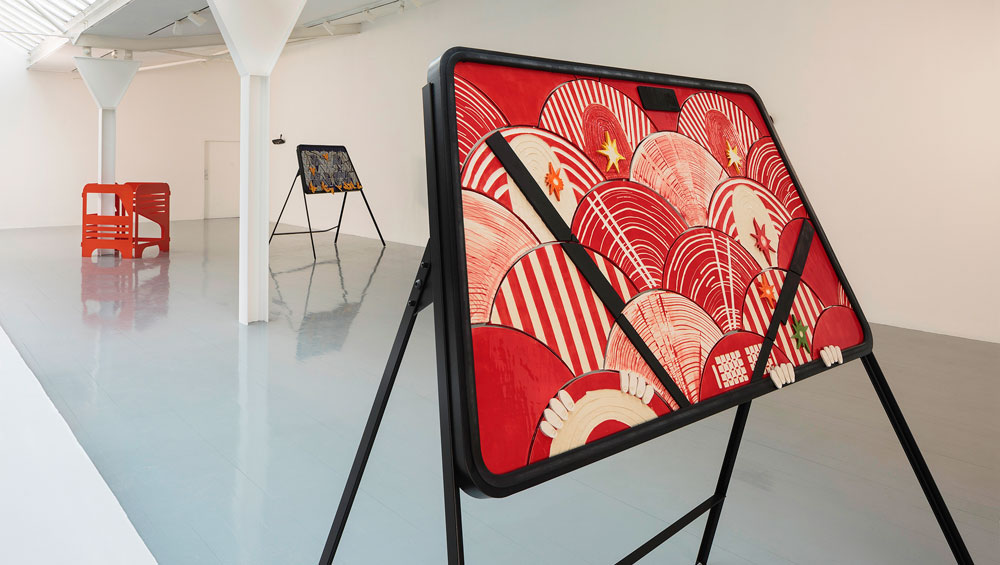
Emma Hart, BANGER. Installation view, The Fruitmarket Gallery, 2018. Courtesy the artist and The Sunday Painter, London. Photo: Ruth Clark.
The Fruitmarket Gallery, Edinburgh
27 October 2018 – 3 February 2019
by CHRISTIANA SPENS
On entering the first room of the Fruitmarket’s latest exhibition, Emma Hart: Banger, visitors are faced with large ceramic objects in the shape of heads, or perhaps measuring jugs, 10 of which are suspended from the ceiling, with patterns painted in their interiors like kaleidoscopic visions. Their shadows, cast on the floor and the walls, look like empty speech bubbles, on which people tentatively stand to peer up into the hanging domes. They look like heavy spotlights and there is a sense that they could fall; this feeling of dread seems to weigh down the atmosphere, as if we are standing in an upside-down, darkened world of the surreal. Immediately, there is a relationship, then, between the art and the visitors, as if the sculptures have somehow marked their territory and patrol it with their angst. Red zigzags on the walls, looking like an out-of-control heart rate on an ECG, contribute to this feeling.
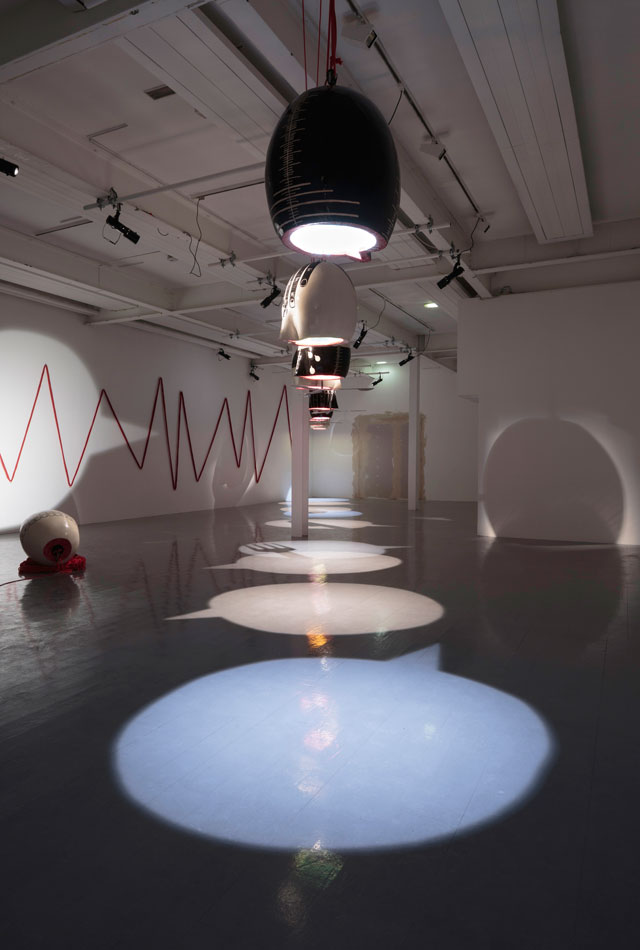
Emma Hart, Mamma Mia!, 2017. Installation view, The Fruitmarket Gallery, 2018. Collezione Maramotti, Reggio Emilia, Italy. Photo: Ruth Clark.
Indeed, for inanimate objects, these sculptures, part of Hart’s Mamma Mia! installation (for which she won the Max Mara Art Prize for Women in 2016) seem almost alive. They are possessed with stories and feelings, the patterns in the “heads” illustrating hostile behaviour identified in family therapy units. The objects themselves hang in “family groups”, alongside slowly moving fans whose blades are ceramic knives, forks and spoons. The feeling recollects (or perhaps simulates) anxious family dinners, tense silences and unspoken conflicts – passive aggression, as household objects. I begin to imagine that these are objects thrown in a meal-time fight, caught mid-air and transformed into an installation.

Emma Hart, Mamma Mia!, (detail) 2017. Installation view, The Fruitmarket Gallery, 2018. Collezione Maramotti, Reggio Emilia, Italy. Photo: Ruth Clark.
That the sculptures are made from clay contributes to this compelling sense of the chaotic domestic scene; as Hart said, her focus on working with ceramics was intended as a way to find the “real” in art. “Clay can be an exciting way to talk about chaos,” she said. “What is immediately important is how personal it is. There’s a very raw direct relationship between the clay and my hands.”
This physical connection, a focus on making, throwing and handling, adds to the fascinating, slightly mysterious sense of the “domestic”, too; the connection with cooking, caring and tending to everyday tasks seems to pulse through the installation itself. The objects are disembodied and abstract, in some sense; arranged as they are, they communicate a feeling of close connection as well as alienation to the processes – both physical and emotional – of family life.
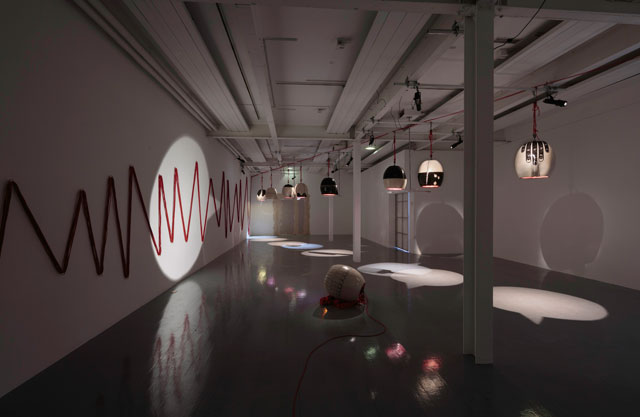
Emma Hart, Mamma Mia!, 2017. Installation view, The Fruitmarket Gallery, 2018. Collezione Maramotti, Reggio Emilia, Italy. Photo: Ruth Clark.
This flurry of feeling and attitude is precisely what Hart has sought to explore and represent: “The domestic is where we can feel every emotion possible,” she explained, “sometimes over a short period of time, for example over a meal.” This sense of time, frozen, creates a fascinating moment to explore – a moment, suspended in time, that is really a microcosm for the feelings and frustrations that play out cyclically in family life and in connected behaviour. Underlying the focus on family relationships is an awareness of the intertwined nature of addictions and anxieties, particularly, it would seem, in relation to food and social gatherings. Hart takes the institution of the family meal and deconstructs the compelling neuroses attached to it, which are themselves as cyclical and inescapable, it would seem, as the family meal itself. There is a sense of being entangled in this scene, which is at once an alien family’s particular set of issues, and one’s own.
This feeling is further heightened by the ever-present red zigzags (which I realise, as I walk further around the exhibition, are, in fact, electrical cables and connect the suspended objects to one another). They begin to look like veins as well as a representation of a heartbeat. Hart also intended these cables to recollect a genogram – a type of family tree that shows both family relationships (mother, father, son, daughter), as well as the quality of individual relationships (loving, claustrophobic, and so on). In this system, the red zigzags signify hostility between family members. Without even knowing about this connotation, however, the sense of drama and stress is clear and magnified, in the exhibition space itself, as well as in the ceramic objects and their interior patterns.
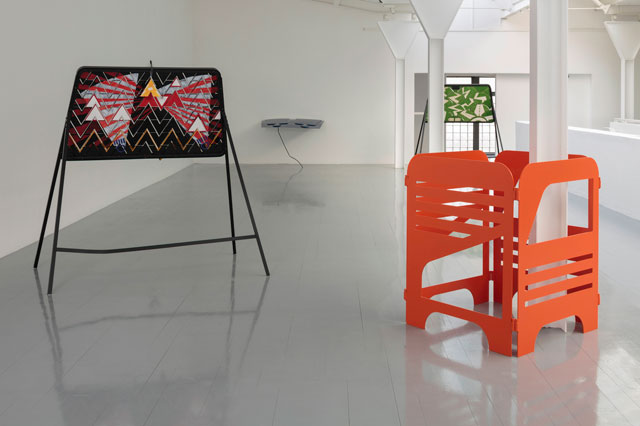
Emma Hart, BANGER. Installation view, The Fruitmarket Gallery, 2018. Courtesy the artist and The Sunday Painter, London. Photo: Ruth Clark.
The sense of danger and anxiety is palpable upstairs, too, with car-themed objects arranged over the large exhibition space, suggesting chaotic events in their associations with one another. There are steering wheels and gates and mirrors strewn (carefully) across the room, implying a car crash or suburban disarray. These new works, created especially for the Fruitmarket’s space, and to complement and develop the ideas of the Mamma Mia! collection, bring the domestic space outside, expanding the drama and heightening the stakes. With pieces of vehicles all over the place, the implication is not only emotional strife, but also death itself.
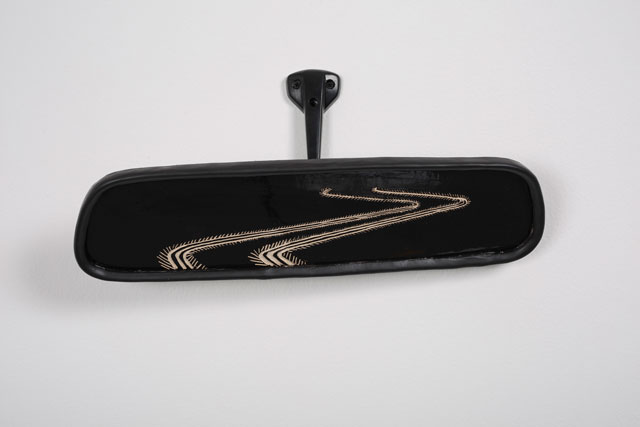
Emma Hart, Slippery Sloped, 2018. Installation view, The Fruitmarket Gallery, 2018. Courtesy the artist and The Sunday Painter, London. Photo: Ruth Clark.
Visitors cannot help but wonder what happened. At first, visiting this second installation feels like stepping over police tape and beginning preliminary investigations of a crime scene. There is no body, though, only these objects. There is a feeling, however – in the shapes and the shadows – that there must be one somewhere. While in Mamma Mia!, the objects were possessed of neuroses, in the upstairs installation, the objects feel disregarded, thrown away, discarded – there is something cathartic in this transition from the almost pregnant emotional turmoil of the womb-like kitchen objects downstairs to the empty, spacious chaos upstairs. It is as if the tensions, in their violent falling out, have been released.
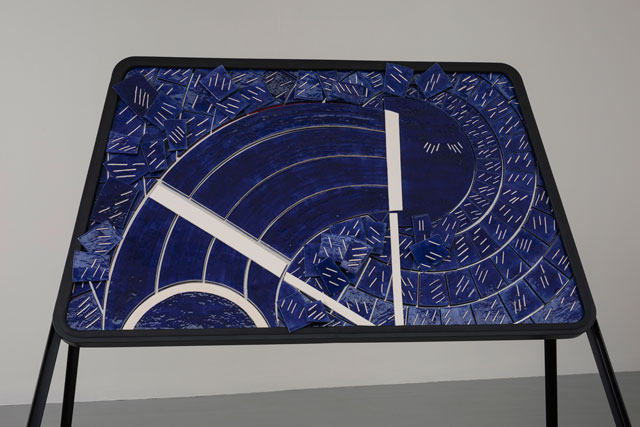
Emma Hart, Wipe Out, 2018. Installation view, The Fruitmarket Gallery, 2018. Courtesy the artist and The Sunday Painter, London. Photo: Ruth Clark.
In this strange fusion of domesticity, the suburban “outside”, and a sense of imminent or recent danger, Hart has created a set for a drama, where the stories have seemingly been sucked into the objects themselves, and then spat out again. What is so compelling about the twin installations is how carefully moulded and arranged this drama is; in delicately balancing tension and catharsis, Hart achieves an elegance as well as the beguiling “realness” she set out of capture.